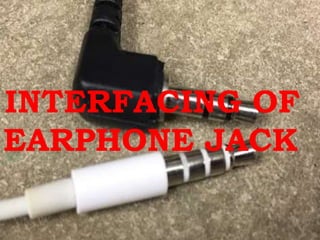Earphone jack
•Download as PPTX, PDF•
1 like•589 views
interfacing of ear phone jack
Report
Share
Report
Share

Recommended
Recommended
More Related Content
Similar to Earphone jack
Similar to Earphone jack (20)
Recently uploaded
Recently uploaded (20)
Basic Civil Engineering Notes of Chapter-6, Topic- Ecosystem, Biodiversity G...

Basic Civil Engineering Notes of Chapter-6, Topic- Ecosystem, Biodiversity G...
How libraries can support authors with open access requirements for UKRI fund...

How libraries can support authors with open access requirements for UKRI fund...
Basic phrases for greeting and assisting costumers

Basic phrases for greeting and assisting costumers
Matatag-Curriculum and the 21st Century Skills Presentation.pptx

Matatag-Curriculum and the 21st Century Skills Presentation.pptx
Solid waste management & Types of Basic civil Engineering notes by DJ Sir.pptx

Solid waste management & Types of Basic civil Engineering notes by DJ Sir.pptx
Sectors of the Indian Economy - Class 10 Study Notes pdf

Sectors of the Indian Economy - Class 10 Study Notes pdf
Welcome to TechSoup New Member Orientation and Q&A (May 2024).pdf

Welcome to TechSoup New Member Orientation and Q&A (May 2024).pdf
Industrial Training Report- AKTU Industrial Training Report

Industrial Training Report- AKTU Industrial Training Report
plant breeding methods in asexually or clonally propagated crops

plant breeding methods in asexually or clonally propagated crops
Earphone jack
- 2. EARPHONE JACK Usually 2.5 and 3.5mm jacks have been used in smart phones and cell phones. While, stereo and home theatre like equipment generally have 6.3mm sockets. In time, the common headphone jack on smart phones is expected to become history, replaced by wireless (Bluetooth).
- 3. Cont…. In 2016, Apple eliminated the headphone jack on the iPhone 7. Older phones used a smaller 2.5mm jack for phone headsets. The 2.5 and 3.5 mm jacks are used with mobile devices, while the 6.3 mm connectors (bottom) are typically found on non-portable equipment. 3.5=diameter of the connector
- 4. SIZE OF SOCKET • 2.5 mm mono (TS) • 3.5 mm mono (TS) • 3.5 mm stereo (TRS) • 6.35 mm ( 1⁄4 in) (TRS)
- 5. JACK Jack : Part of the earphone which takes electrical signals from the audio output port of the devices like mobile phones, laptop, computers, music player etc. There are three contact areas known as the TIP, RING and the SLEEVE as shown in the image and therefore this connector is also called as TRS connector.
- 6. CONSTRUCTION A phone connector, also known as phone jack, audio jack, headphone jack or jack plug, is a family of electrical connector typically used for analog signals. The phone connector was invented for use in telephone switchboards in the 19th century and is still widely used. It is cylindrical in shape, with a grooved tip to retain it. In its original audio configuration. It typically has two, three, four and, occasionally, five contacts. Three- contact versions are known as TRS connectors, where T stands for "tip", R stands for "ring" and S stands for "sleeve". Ring contacts are typically the same diameter as the sleeve, the long shank. Similarly, two-, four- and five- contact versions are called TS, TRRS and TRRRS connectors respectively. The outside diameter of the "sleeve" conductor is 1⁄4 inch (6.35 millimeters). The "mini" connector has a diameter of 3.5 mm (0.14 in) and the "sub-mini" connector has a diameter of 2.5 mm (0.098 in).
- 7. COMPLETE CIRCUIT At the most basic level, an earphone is a loop of wire with current running through it. This electric current in the loop then interacts with a permanent magnet which in turn pushes the air—that's sound.
- 8. TRS AUDIO JACK TRS audio plugs are found on standard stereo headphones that don’t have a microphone. After you cut into the cable, you’ll probably find one of three common ways these can be wired: Copper wire ground sheath wrapped around two insulated audio signal wires. Two separate insulated wires, each with its own signal wire and a ground wire inside. Separate insulated wires for the ground, right audio, and left audio inside a single cable. Usually red wires are the right audio channel and blue wires are the left audio channel.
- 10. THIS IS HOW WIRES ARE CONNECTED TO THE PIN
- 11. TRRS AUDIO PLUG The TRRS audio plug is found on iPhone headphones and other headphones that have a microphone. After you cut open the plastic insulating sheath you’ll find 5 separate wires: Solid red wire: right audio channel signal Red and copper twisted wire: ground for the right audio channel Solid green wire: left audio channel signal Green and copper twisted wire: ground for the left audio channel Red and green sheath with a copper wire inside: Inner copper wire is the microphone signal, outer sheath is the microphone ground.
- 12. TRRS JACK
- 13. LAYOUT DIAGRAM
- 14. TRANSFERING THE MESSAGE Encodes the message [ ASCII or morse code]. Convert encoded message into audio signal. Send the audio signal. Receives audio signal. Interrupts [filter] audio signal. Decodes digital signal into original message.
- 15. SAMPLING FREQUENCY The total number of time the signal is sampled in one second is called as sampling frequency. Only 44.100hz is guaranteed on all android devices.